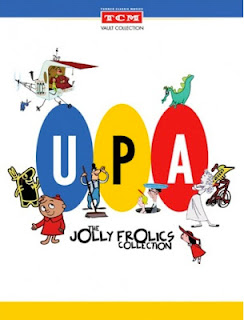Jolly Frolics
 The DVD collection of UPA Jolly Frolics is now available for pre-order through both the TCM website as well as Movies Unlimited. The pre-release price is $34.99 U.S. For those of you ordering in Canada, Movies Unlimited offers the better deal in that they're charging $8 for postage, where TCM wants $20.
The DVD collection of UPA Jolly Frolics is now available for pre-order through both the TCM website as well as Movies Unlimited. The pre-release price is $34.99 U.S. For those of you ordering in Canada, Movies Unlimited offers the better deal in that they're charging $8 for postage, where TCM wants $20.The importance of these cartoons has probably been dulled by time, but when they were released, they shook the foundations of American animation and were widely influential around the world. Prior to UPA, the bulk of American animation was built on the Disney design model, where characters were drawn to be dimensional. While American animation had progressed beyond the circle and hosepipe design approach, it was still based on rounded forms that could be turned in space and that had definite volume. There was also a discontinuity between characters who were painted in flat colours and backgrounds that were rendered to give the impression of light hitting rounded forms. Each American studio had a house style that was a variation on the above.
UPA embraced a flatter graphical approach in their backgrounds, which made the overall design of their films more consistent. In addition, they varied their design approach in each cartoon. While the artists there shared a design sensibility, they worked to avoid developing a house style.
Their films also differed in content. By the time UPA arrived on the theatrical cartoon scene in the late 1940s, American animation had hardened into formula. Slapstick conflict was the norm, whether it was Donald Duck vs. Chip and Dale, Bugs vs. Elmer, Tom vs. Jerry, Popeye vs. Bluto, Woody Woodpecker vs. Buzz Buzzard, or Mighty Mouse vs. Oil Can Harry. UPA returned to stories similar to Disney's Silly Symphonies of the 1930s, albeit with their own sense of design.
The cartoons in this set include Gerald McBoing Boing (written by Dr. Seuss), The Unicorn in the Garden (based on the story by James Thurber), The Tell Tale Heart (based on the story by Edgar Allen Poe) and Madeline (based on the book by Ludwig Bemelmans). In the case of the Thurber and Bemelmans shorts, the films are designed based on the art of the authors.
In addition, there are original cartoons directed by John Hubley (Rooty Toot Toot), Bobe Cannon (Christopher Crumpet) and Art Babbitt (The Family Circus). Hubley, of course, went on to create many independent films such as Moonbird after leaving UPA. Cannon is, in my opinion, an animator and director who deserves much more attention than he's been given. While he animated for Tex Avery and Chuck Jones, his films are very different in tone and subject matter than his animation.
While there are still studios that are underrepresented on DVD such as Terrytoons and Mintz/Columbia, this is one of the most important DVD releases of the last several years. Based on the influence these films had on everything that came after them and the high quality of many of these cartoons, it's about time that they are available. They fill a large hole in American animation history.

The Unicorn in the Garden




Comments
Post a Comment